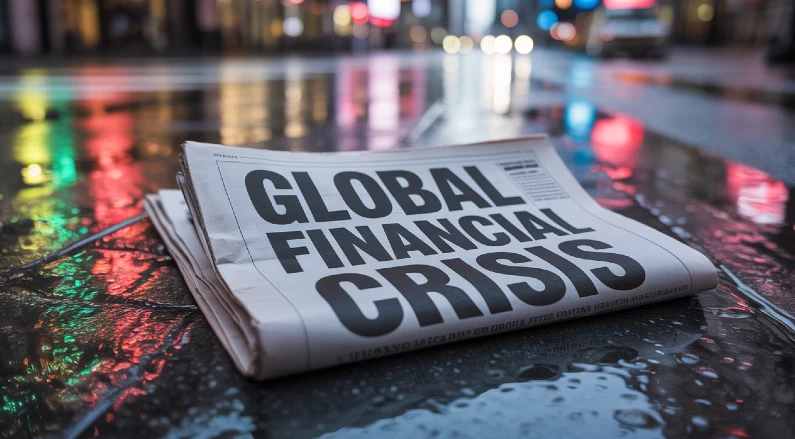Navigating the Aftermath: Understanding the Global Financial Crisis
The Global Financial Crisis (GFC) of 2007–2008 stands as one of the most devastating economic collapses in modern history—surpassed only by the Great Depression of the 1930s. Originating in the U.S. housing and credit markets, the crisis quickly spiraled into a worldwide financial meltdown, exposing the vulnerabilities of an increasingly interconnected global economy. Within months, banking giants failed, stock markets plummeted, and millions of people lost their homes, jobs, and retirement savings.
The ripple effects were felt across virtually every sector, from real estate and finance to manufacturing and international trade. Trillions of dollars in wealth were wiped out, credit markets froze, and governments scrambled to prevent total systemic collapse through massive bailouts and unprecedented stimulus measures.
Understanding the underlying causes, the chain reaction of events, and the policy responses that followed is critical—not only for historians and economists but for policymakers, investors, and everyday citizens. The lessons learned from the GFC have since shaped financial regulations, risk management strategies, and global economic policies designed to prevent a similar catastrophe in the future.
This comprehensive analysis explores the root causes, widespread impacts, key players, and long-term consequences of the Global Financial Crisis—and why it remains a defining moment in 21st-century economic history.

🧨 The Genesis of the Crisis
The seeds of the crisis were sown in the early 2000s, during a time of deregulation, financial innovation, and an overconfidence in markets. At the center of it all was the U.S. housing market.
Key Triggers:
Lax Lending Standards: Banks approved mortgages to borrowers with poor credit histories (subprime loans) without sufficient documentation or risk assessment.
Securitization of Mortgages: Lenders packaged high-risk mortgages into complex financial instruments like mortgage-backed securities (MBS) and collateralized debt obligations (CDOs), selling them to investors under the false premise of safety.
Over-Leverage: Financial institutions borrowed excessively to invest in these high-risk instruments, magnifying potential losses.
Rating Agency Failures: Credit rating agencies inaccurately rated risky securities as AAA, giving a false sense of security to investors.
Together, these practices created a fragile financial ecosystem, vulnerable to a shock. That shock came when housing prices began to decline and borrowers started defaulting on their loans en masse.
🏦 Impact on Financial Institutions
📉 Wave of Bank Failures
As mortgage defaults soared, the value of mortgage-backed securities collapsed. Financial institutions holding these assets suffered enormous losses. Among the casualties:
Lehman Brothers filed for bankruptcy in September 2008, the largest in U.S. history.
Bear Stearns and Merrill Lynch were forced into emergency acquisitions.
AIG, one of the world’s largest insurers, required a $182 billion government bailout.
Banks worldwide faced liquidity crises, and interbank lending ground to a halt, eroding confidence in the financial system.
📊 Global Stock Market Crash
Equity markets plummeted:
The S&P 500 lost over 50% of its value between 2007 and 2009.
The Dow Jones Industrial Average fell by over 5,000 points.
Global indices in Europe and Asia also suffered heavy losses.
Investor panic triggered mass sell-offs, further deepening the crisis.
🌐 Effects on Global Economies
📉 Severe Recession and Soaring Unemployment
The ripple effects extended far beyond the financial sector:
GDP contracted in the U.S., U.K., Eurozone, and many other economies.
Global trade slowed drastically.
Unemployment skyrocketed, with over 8.7 million jobs lost in the U.S. alone between 2007 and 2009.
🏚️ Housing Market Fallout
Home prices fell by over 30% in some U.S. regions.
Millions of homeowners found themselves underwater, owing more than their homes were worth.
Foreclosures surged, displacing families and devastating communities.
🛠️ Policy Responses and Recovery Efforts
Governments and central banks intervened to stabilize economies and restore confidence in the financial system.
💵 Government Stimulus Packages
Countries injected trillions of dollars into their economies through:
Bailouts of banks and insurers (e.g., TARP in the U.S.)
Direct financial aid to consumers and businesses
Infrastructure spending and job creation programs
These interventions helped prevent total economic collapse and laid the groundwork for recovery.
🏛️ Monetary Policy: Zero and Negative Rates
Central banks, including the Federal Reserve, European Central Bank, and Bank of England, slashed interest rates to near zero.
They launched quantitative easing (QE) programs, purchasing government bonds and toxic assets to inject liquidity and encourage lending.
🧾 Financial Regulation Reforms
The GFC exposed severe flaws in the global financial system, prompting sweeping reforms:
Dodd-Frank Wall Street Reform and Consumer Protection Act (U.S.)
Basel III international banking regulations to strengthen capital requirements
Stress tests and liquidity buffers for financial institutions
Enhanced consumer protection laws and creation of agencies like the Consumer Financial Protection Bureau (CFPB)
These reforms aimed to improve transparency, reduce systemic risk, and prevent excessive risk-taking.

📈 Long-Term Economic and Societal Impacts
🌍 Global Trust in Financial Institutions Shattered
The crisis deeply eroded public trust in banks, regulators, and rating agencies. Widespread anger and frustration fueled the rise of populist political movements, calls for stricter regulations, and growing skepticism toward capitalism.
💰 Wealth Inequality Widened
While the wealthiest recovered quickly thanks to rising stock prices and asset inflation, low-income households and minorities faced long-term job losses, wage stagnation, and housing insecurity — exacerbating inequality.
🏡 Changes in Consumer Behavior
A rise in saving rates
More cautious borrowing and investing
Increased interest in financial literacy and budgeting
🔄 Evolution of Financial Technology
The crisis accelerated the adoption of fintech, online banking, and cryptocurrencies as consumers sought greater control over their financial futures and alternatives to traditional banks.
💡 Lessons Learned from the Global Financial Crisis
1. Oversight is Essential
A key lesson is the need for strong, transparent regulation of financial markets and institutions. Without proper oversight, innovation can turn into exploitation.
2. Too Big to Fail = Too Risky to Ignore
Large financial institutions that are interconnected and underregulated can pose systemic risks. Policies now aim to prevent banks from becoming too large and to implement resolution frameworks in case of failure.
3. Financial Literacy Matters
Many homeowners signed complex mortgage agreements without fully understanding the risks. Promoting financial education is now recognized as critical for protecting consumers.
4. Risk Must Be Properly Priced
Rating agencies failed to assess the true risk of mortgage-backed securities. Risk modeling must be robust, and incentives must be aligned with long-term performance rather than short-term profits.
5. Global Cooperation Is Crucial
The crisis showed how interconnected the global economy is. Coordinated international efforts — such as G20 summits, IMF lending, and central bank cooperation — were vital in navigating the fallout.
🔍 FAQs About the Global Financial Crisis
Q1: What triggered the Global Financial Crisis?
The primary triggers were subprime mortgage defaults, excessive financial leverage, and the collapse of complex financial instruments like CDOs.
Q2: How long did the crisis last?
The peak of the crisis occurred between 2007 and 2009, but its economic effects lingered for several years, with full recovery taking over a decade in some countries.
Q3: Could the GFC have been prevented?
Many economists argue it could have been mitigated through better regulation, stricter lending standards, and more transparent financial practices.
Q4: Did the crisis affect all countries equally?
No. While it originated in the U.S., it spread globally, impacting advanced and emerging economies differently based on their financial exposure and policy responses.
Q5: Is the world prepared for another crisis?
Financial systems are more resilient today due to reforms, but emerging risks like cyber threats, climate change, and shadow banking continue to pose new challenges.
🧾 Conclusion: A Crisis That Changed Everything
The Global Financial Crisis was more than a market crash — it was a wake-up call. It exposed systemic flaws, reshaped regulations, and altered the financial landscape permanently. While governments and institutions have taken steps to reduce the chances of a repeat, the lessons of the GFC must remain front and center.
A vigilant, transparent, and inclusive financial system — coupled with educated consumers and accountable institutions — is the best defense against future economic calamities.
By understanding the root causes and long-term impacts of the crisis, we are better equipped to build a more resilient, sustainable, and equitable global economy.

Eduard Kingly is a travel and lifestyle content creator with a focus on personal development and education. He combines firsthand travel experiences with research-driven insights to guide readers in discovering new places, building better habits, and pursuing meaningful learning.




